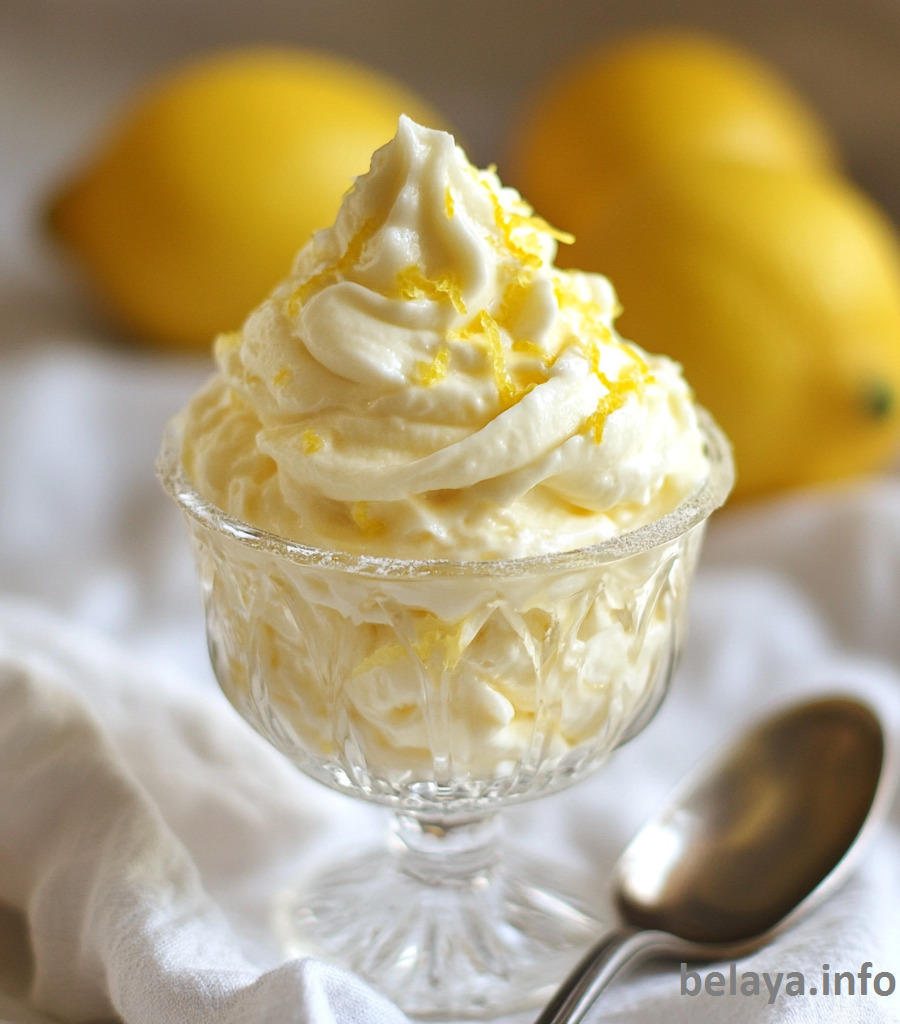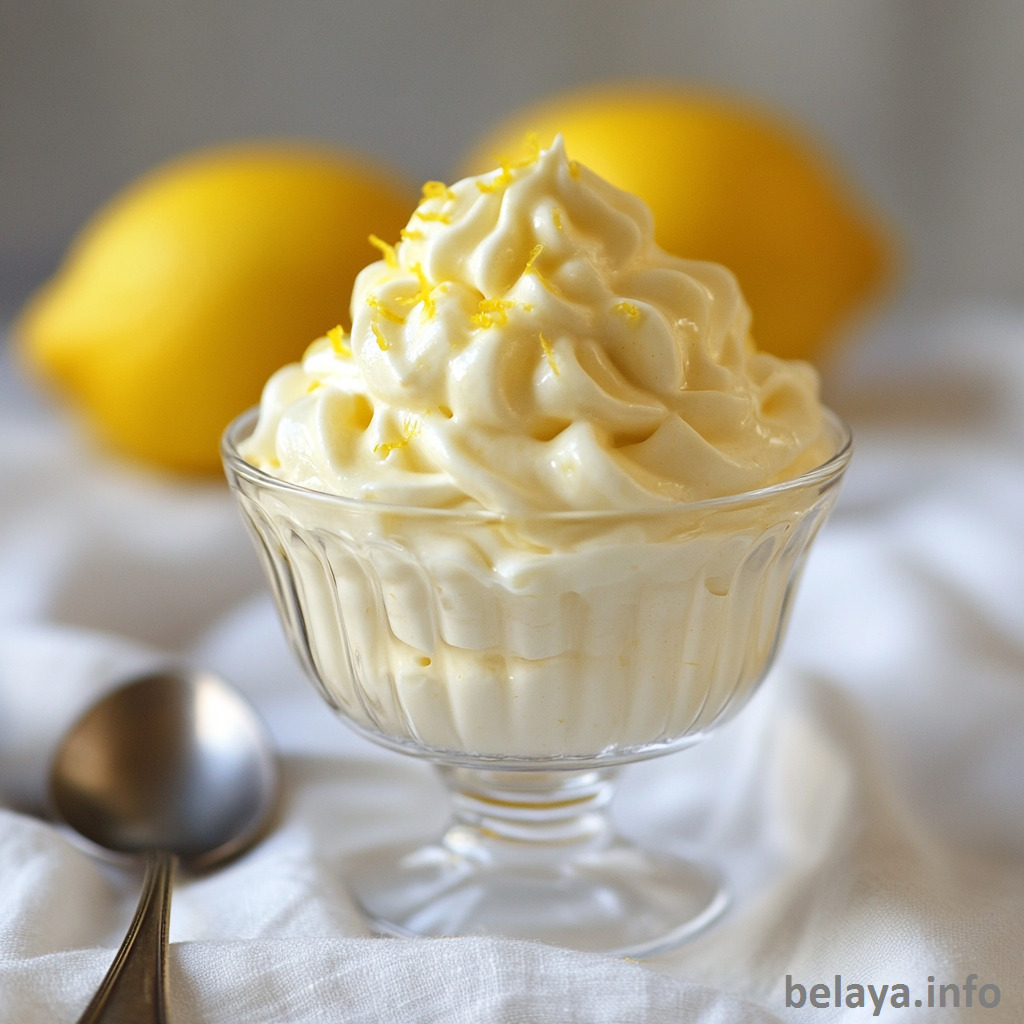Lemon Syllabub
Delicate yet indulgent, Lemon Syllabub is a centuries-old English dessert that captures the essence of refined simplicity. With its airy texture and bright citrus notes, it offers a refreshing contrast to rich meals—light on the palate but rich in character.
This dessert blends the luxuriousness of whipped cream with the sharpness of lemon and a hint of sweetness, creating a silky spoonful that’s both timeless and soothing.
Whether made with juice or a splash of sherry, it’s a graceful nod to culinary history that still feels utterly modern.

Why People Will Love This Lemon Syllabub Recipe:
Elegant simplicity: With just a handful of ingredients, this dessert transforms into something luxurious and memorable—proof that beauty lies in restraint.
Bright, refreshing flavor: The citrusy sharpness of lemon balances the cream’s richness, cleansing the palate and satisfying sweet cravings without being heavy.
Historical charm: As a dessert with roots in 16th-century England, it offers a timeless, nostalgic experience that connects us to culinary tradition.
Effortless yet impressive: It’s quick to prepare but looks and tastes like something far more elaborate—perfect for entertaining with minimal stress.
Versatile and customizable: Whether made with lemon juice, apple cider, or a splash of sherry or brandy, it adapts beautifully to different tastes and occasions.
Light and soothing finish: Ideal as a post-dinner treat, especially after a rich or heavy meal—it leaves guests feeling refreshed and delighted.

Key Ingredients:
Heavy cream forms the luxurious foundation of this dessert—when whipped, it transforms into a silky, cloud-like texture that defines the dish’s indulgence.
Fresh lemon juice and zest bring a vibrant, tangy brightness that cuts through the richness, delivering both flavor and aromatic lift with every spoonful.
Granulated sugar adds just the right touch of sweetness, allowing the natural tartness of the citrus to shine without overwhelming the palate.
Vanilla extract introduces a subtle warmth and floral note that softens the citrus edge, rounding out the flavor profile with elegance.
A splash of acidic juice or fortified wine (like apple cider or sherry) enhances the texture and deepens the complexity, evoking the dessert’s historical roots and balancing lightness with depth.

Expert Tips:
Use cold cream and chilled tools: For the best whip, start with cream straight from the fridge and use a chilled mixing bowl and beaters. This ensures maximum volume and a stable structure.
Zest before juicing the lemon: Always zest the lemon first—it’s much easier when the fruit is whole. The zest adds essential aromatic oils that infuse the cream with a bright, natural citrus depth.
Don’t overwhip: Whip just until stiff peaks form. Overwhipping can cause the cream to separate, turning your delicate dessert into a grainy mixture. Look for a smooth, billowy texture.
Choose high-quality vanilla extract: Since there are few ingredients, each one counts. Real vanilla (not imitation) provides warmth and complexity that enhances the lemon without overpowering it.
Adjust the acid to your taste and pairing: Lemon juice gives a bold tartness, while apple cider or sherry adds subtle depth. If serving after a heavy meal, lean into brighter citrus. For an elegant dinner, a touch of sherry adds refinement.
Let it chill and set: At least one hour in the fridge helps the flavors meld and the texture firm up. The result is a cool, spoonable dessert that’s soft yet structured.
Serve in elegant glassware: Presentation enhances enjoyment. Layer syllabub in coupe glasses, wine glasses, or mini jars, and garnish with a twist of lemon zest or edible flowers for a stunning finish.

Lemon Syllabub
Ingredients:
1½ cups cold heavy whipping cream
¼ cup white granulated sugar
2 tablespoons of your preferred acidic liquid – such as apple cider, apple juice, lemon juice, or for a traditional twist, sherry or brandy
Zest and juice of 1 large fresh lemon
½ teaspoon pure vanilla extract
Instructions:
In a large mixing bowl, combine the heavy cream, granulated sugar, your choice of acidic liquid (such as apple cider, lemon juice, or a splash of sherry), freshly squeezed lemon juice, lemon zest, and vanilla extract.
Using a hand mixer or whisk, whip the mixture until it becomes thick and forms stiff peaks.
Cover the bowl with plastic wrap and refrigerate for at least 1 hour to allow the flavors to meld and the texture to set.
Once chilled, spoon the syllabub into individual serving glasses or bowls. Serve cold and enjoy the silky, citrusy delight.

Important Notes When Making Lemon Syllabub:
Balance is key: The beauty of syllabub lies in the harmony between rich cream and sharp acidity. Too much lemon can overpower; too little can leave it dull. Taste and adjust gently before whipping.
Texture defines success: The goal is a silky, mousse-like consistency—light but with enough body to hold its shape. Achieving stiff peaks without overbeating is crucial to preserving its delicate structure.
Freshness matters: Use freshly squeezed lemon juice and zest for the brightest, cleanest flavor. Bottled alternatives often lack the essential oils and nuanced sharpness that define this dessert.
Alcohol is optional but historical: Traditional syllabub was made with sherry or white wine, adding subtle depth and a faintly boozy warmth. Modern versions use juice for a family-friendly twist, but a splash of fortified wine can restore its old-world elegance.
Short shelf life: Syllabub is best enjoyed within 24 hours. Over time, the whipped cream may begin to loosen or weep, especially if stored uncovered. For best results, chill it well and serve fresh.
Minimal ingredients, maximum expression: With so few components, each must be thoughtfully chosen and properly handled. This dessert celebrates simplicity, but every detail—from the cream’s chill to the lemon’s zest—affects the final result.

How To Enjoy Lemon Syllabub After Cooking
Let it chill completely
After whipping and portioning the syllabub, be sure to refrigerate it for at least 1 hour. This resting time allows the flavors to meld and the cream to firm up, creating a silky texture that melts beautifully on the tongue.
Serve in elegant portions
Lemon Syllabub shines when presented in small, transparent glasses, coupe dishes, or vintage tea cups. The light color and airy texture deserve visual celebration.
Garnish with care
Add a finishing touch just before serving:
- A twist of lemon zest for added brightness
- A fresh raspberry or blueberry for color contrast
- A sprig of mint for aroma and elegance
- A thin biscuit or shortbread on the side for texture balance
Pair with complementary flavors
This dessert is light yet flavorful, making it ideal after a heavy meal. Pair it with:
A crisp glass of chilled white wine (like Riesling or Moscato)
Sparkling water with lemon for a non-alcoholic option
Light herbal teas (e.g., chamomile or lemon verbena)
Serve it chilled, not frozen
Lemon Syllabub should be served cold but soft—not icy. Avoid placing it in the freezer, as it can lose its smooth texture and separate when thawed.
Eat slowly and savor
This is not a dessert to rush. Take small spoonfuls and let the balance of sweet cream and bright citrus unfold gradually. It’s meant to refresh and delight the palate, especially after rich or savory meals.

Nutrition Information (per serving):
For Lemon Syllabub, based on 6 servings
Calories: 265 kcal | Total Fat: 22.6 g | Saturated Fat: 14.3 g | Monounsaturated Fat: 6.0 g | Polyunsaturated Fat: 0.7 g | Cholesterol: 82 mg | Sodium: 18 mg | Total Carbohydrates: 14.5 g | Dietary Fiber: 0.2 g | Sugars: 13.2 g | Protein: 1.5 g
Note: These values are approximate and based on typical ingredient profiles. Exact values may vary depending on the type of acidic liquid used (juice vs. sherry), and brand variations of cream or sugar.

Frequently Asked Questions:
Can I make Lemon Syllabub ahead of time?
Yes! It’s actually best made a few hours in advance. Prepare and chill it for at least 1 hour, but you can store it covered in the refrigerator for up to 24 hours. Beyond that, the texture may start to break down.
Can I substitute the heavy cream with a dairy-free alternative?
You can use full-fat coconut cream as a substitute, but note that it will change the flavor. Make sure it’s well chilled and whip only the thick portion for the best texture. Other non-dairy creams may not whip to stiff peaks.
Does Lemon Syllabub contain alcohol?
Traditionally, it does—usually sherry or brandy. However, this recipe offers non-alcoholic alternatives like apple juice or lemon juice. You can choose based on your preference or the occasion.
What’s the best way to serve Lemon Syllabub?
Serve it in small glasses or ramekins for an elegant presentation. Garnish with lemon zest curls, a fresh berry, or a crisp biscuit on the side for contrast in texture.
Why didn’t my syllabub set properly?
If it’s too runny, the cream may not have been whipped to stiff peaks, or the liquid ratio was too high. Make sure the cream is very cold before whipping, and avoid adding too much juice or alcohol.
When should I stop whipping the cream for the perfect texture?
Stop whipping as soon as stiff peaks form—when the cream holds its shape firmly but still looks smooth. Overwhipping can lead to graininess or even butter-like separation, ruining the light texture.
Can I mix everything together at once, or should I whip the cream first?
It’s best to add all ingredients at the start, including the citrus and juice/alcohol, then whip them together. This allows the acidity to slightly thicken the cream as you whip, helping the mixture set with flavor fully incorporated.
Why is my cream not thickening when whipped with lemon juice or cider?
The cream must be very cold. Warm cream won’t whip properly, especially when combined with acidic ingredients. Chill your bowl and beaters as well for best results.
Can I use a whisk instead of an electric mixer?
Yes, but it requires more effort. Whipping by hand takes longer and demands consistent motion. It’s doable and satisfying, but for the ideal texture with less risk of underwhipping, a hand or stand mixer is recommended.
Should I strain the lemon juice or zest before adding?
It’s not necessary, but straining the juice removes pulp and seeds for a smoother texture. The zest should be finely grated to evenly distribute flavor without unpleasant bites of peel.